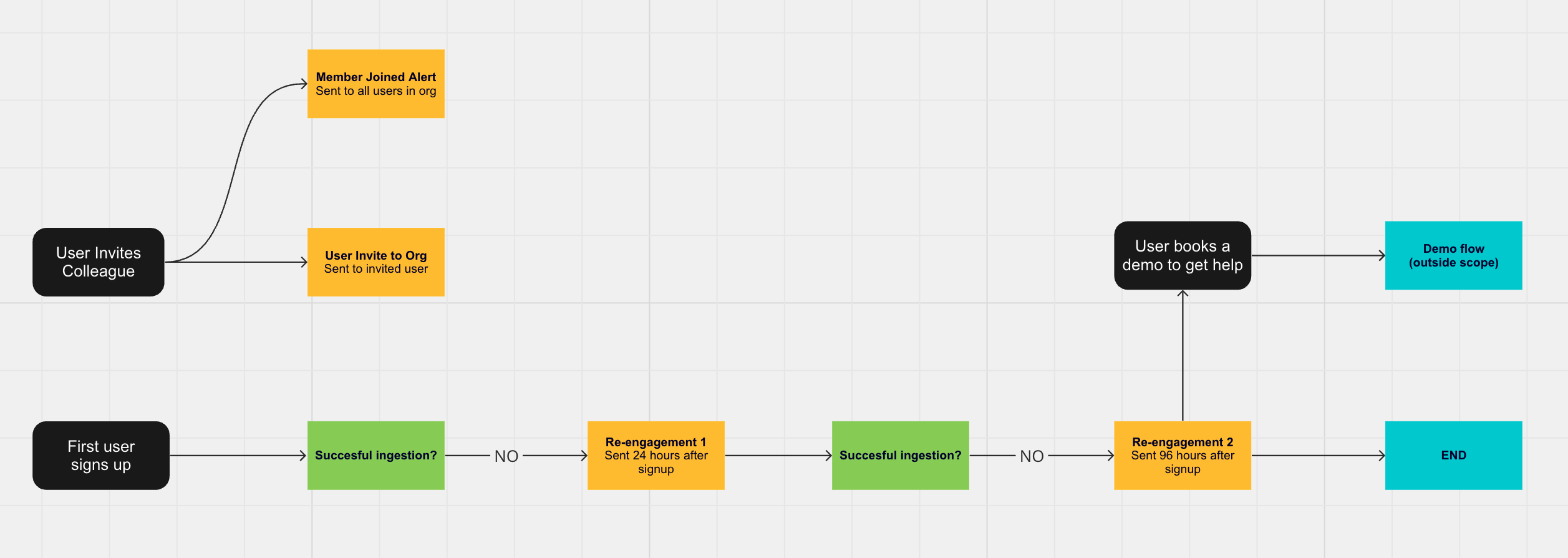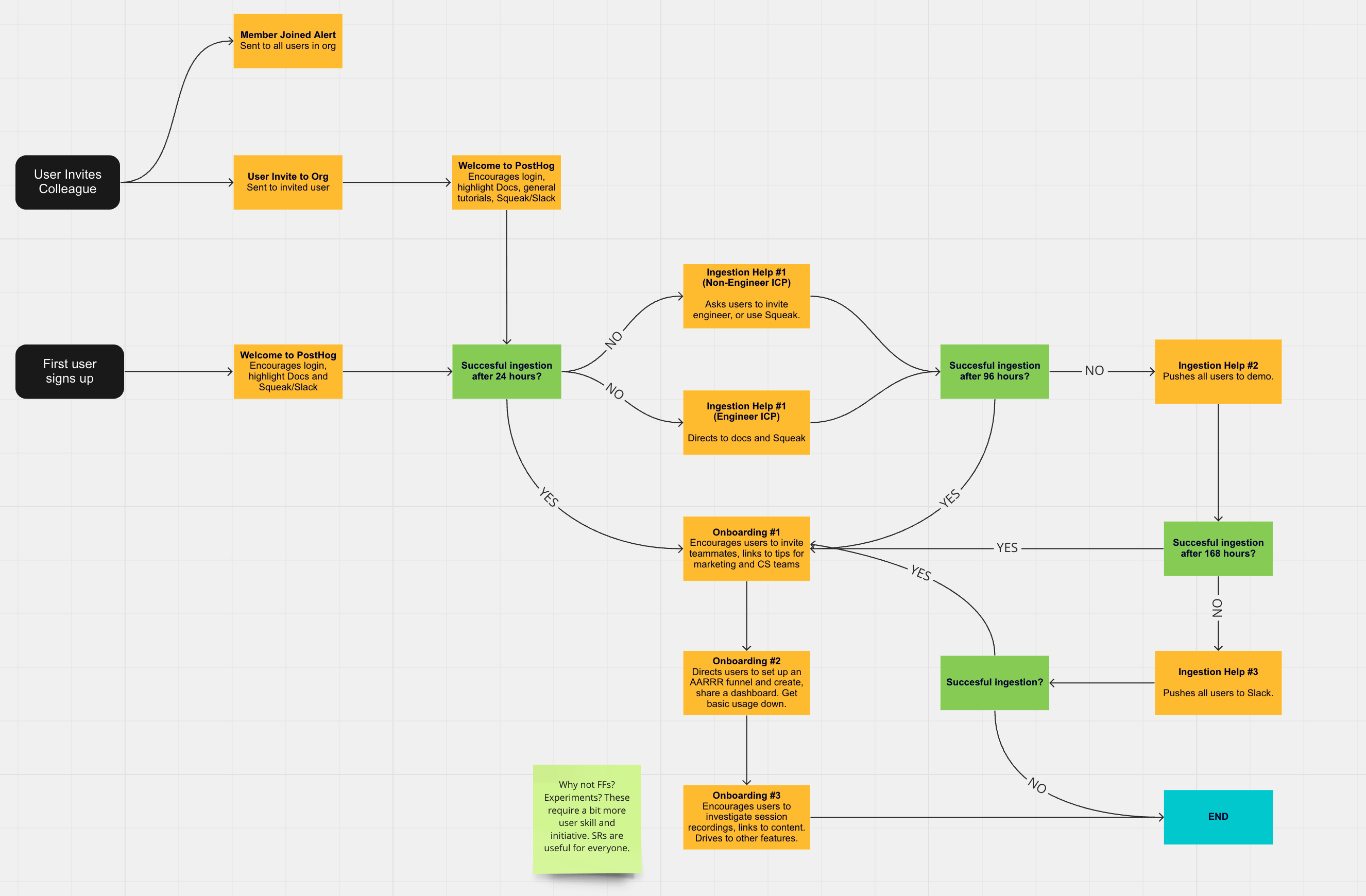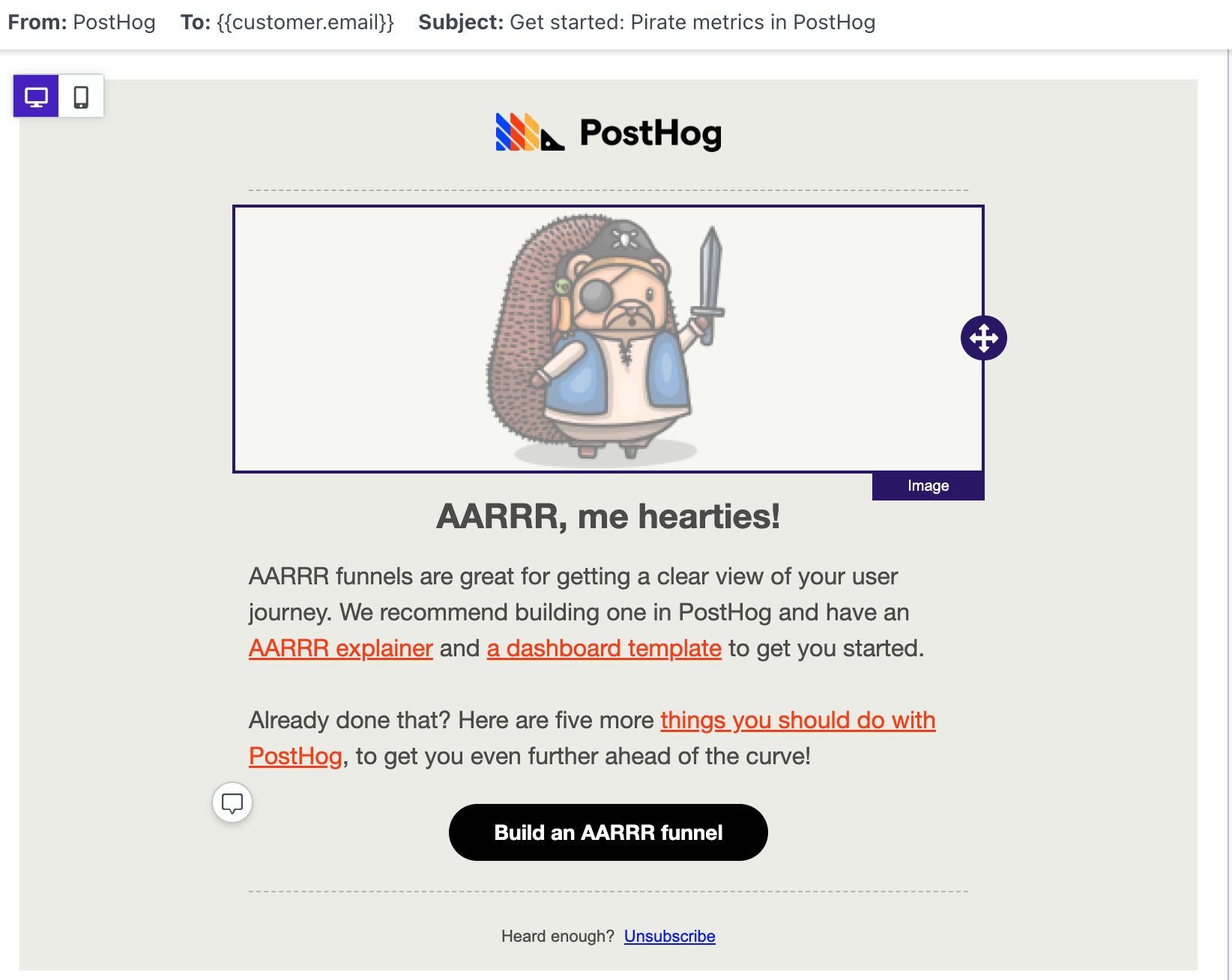How we built our onboarding email flow (with actual performance data)
Feb 19, 2024

On this page
- Onboarding 1.0: The one where it started costing lots
- Onboarding 2.0: The one where we chose a new email tool
- Onboarding 3.0: The one where we started tracking data
- Onboarding 3.1: The one where we added personalization
- Onboarding 3.3: The one where we added experiments
- Onboarding 4.0: The one where we filtered by ICP
- Onboarding 5.0: The gosh-thats-complicated one
- Onboarding 6.0: The current one
- What we learned
- Email works for engineers too
- You can send more emails than you think
- Users prefer fun visual art to screenshots
- Personalization matters
Updated July 26, 2024: Added information about Onboarding 6.0
Marketers believe onboarding emails are a powerful tool for driving engagement. Everyone else thinks they're annoying and ineffective. The truth, as always, is a little more complicated.
People, and developers in particular, hate onboarding campaigns because the bad ones are so memorable. And how would you know what "good" looks like without signing up and risking a flood of tedious outreach emails from sales reps?
We don’t do those sort of outreach emails. This is what we do instead, and how we got there over 5 major iterations. We think it works and we've included performance data so you can judge for yourself.
Onboarding 1.0: The one where it started costing lots
Back in 2022, our onboarding flow was powered by Mailchimp and was very simple. In fact, nobody actually knew what it looked like. So, I mapped it in an RFC.

We didn’t do welcome emails for new users, and even our monthly changelog emails were only sent to 660 opted-in users. I decided to change this and imported 30,000+ users into that email list.
The move was covered by our T&Cs and, because it was one email a month about actual product updates, we figured nobody would mind. The good news was that we were right and didn't get a single complaint and only a handful of unsubscribes.
The bad news is that it sent our Mailchimp costs skyrocketing. This is because Mailchimp's pricing is based partly on how many emails you send each month, and it has low limits that make it entirely unsuited for a complex onboarding campaign. We started searching for a platform with more predictable and scalable pricing.
Onboarding 2.0: The one where we chose a new email tool
Towards the end of 2022, we finally moved off of Mailchimp. We looked at tools such as Braze, Hubspot, and Customer.io, ultimately choosing the latter because it had more transparent pricing and we had an existing app for pushing data to it. Signing the deal was arduous – Customer.io wanted almost ten separate meetings before they took our money, but at least they didn't send any awful sales outreach emails!
I’d observed from other companies that we needed to at least add a welcome email for new users, and I wanted to add checks after 24, 96, and 168 hours to see if users had ingested events. If yes, we’d send them some basic usage advice. If no, we’d offer them help. This was the very least I felt we could do.

This didn’t perform as well as you’d think, however, mainly because the ingestion checks were unreliable. Users kept complaining about getting the wrong emails, so we threw this all out and moved to a new plan.
💡 Tip: Something we learned for our welcome email was not to send it immediately after sign-up. The email is meant to give users initial direction, but first they need to set up ingestion – we added a one hour delay so that users can get data to work with first.
Onboarding 3.0: The one where we started tracking data
By Q3 2023, we were adding more and more new products to PostHog. We wanted to feature these in our flow, but we were also worried about becoming spammy. Thankfully, now that we had Customer.io in place, we were able to judge this based on the data.

Our conversion event was a user log-in within one week of opening an email. We hadn’t yet thought of anything better.
- Open rate: 56%
- Click-through-rate: 7.4%
- Conversion rate: 3%
- Unsubscribe rate: 0.6%
Based on this high open rate and low unsubscribe rate we felt that users didn't mind getting the emails, and the click-through rate suggested they liked what they read. So, we continued adding more messages.
What does good look like for an email onboarding flow? Benchmarks vary wildly by industry, implementation, and product. As a rule though, the guideline benchmarks I use from my experience in other startups are:
- Open rate: Anything above 40% is OK. 50% is the goal.
- Click-through-rate: Anything above 4% is OK. 6% is the goal.
- Conversion rate: Anything above 3% is OK. 5% is the goal.
- Unsubscribe rate: Anything below 1% is OK. 0% is the goal.
Onboarding 3.1: The one where we added personalization
Data is important, but I strongly believe it doesn’t tell the whole story. You also need feedback and intuition. Most of the feedback on our emails came in 3.1, when we started sending personalized recommendations to users from my personal email.
How this works is simple: when a user signs up, they can optionally tell us what their role is. If their role_at_organization = engineer we trigger an email from me telling them about our Product for Engineers newsletter.

This email performed very well, with a 68% open rate and a 16% CTR. Two emails into the flow and developers were already opting in to more emails!
Best of all, though, because it was personalized and came from me directly, it also earned a steady trickle of replies. I responded in kind and was able to feed in further improvements, including adding another option for role_at_organization = founder.
Onboarding 3.3: The one where we added experiments
In 3.3, we started running a series of tests and experiments. We removed the founder targeted email, which invited teams to join PostHog for Startups, because it was too successful and cannibalised revenue.
Most of the tests we ran proved inconclusive, or outright failed. Subtle changes to subject lines or body copy had no noticeable impact. We learned that users did slightly prefer Lottie’s hedgehog art over screenshots of the app, but the difference was a negligible 1-2% in CTR.
One successful experiment we did roll out was adding more personalized emails for non-technical users. If role_at_organization = marketing, sales or product and a user had not created an action within 12 hours, I’d send them another personal tip. These emails averaged a steady 6% CTR and 54% open rate, so we kept them in, but interestingly I didn't see many replies on these messages.
Onboarding 4.0: The one where we filtered by ICP
4.0 was a massive step up in complexity as a result of our growing number of features. By late 2023 the flow had 28 separate emails, of which users would get a maximum of 6 over several weeks. We still worried this would be too many, but the low (0.4%) unsubscribe rate suggested otherwise.

By this point we’d also changed our conversion event to mean a user enabling billing for a product within one week of opening an email - a far better indicator of if the emails are delivering value than simply measuring logins.
- Open rate: 52%
- Click-through-rate: 4%
- Unsubscribe rate: 0.4%
- Conversion rate: 6%
Around this point we also started filtering out teams in our ideal customer profile (ICP) using a scoring system implemented in Hubspot. If a user scored over a certain threshold they’d be moved out of the usual flow so our customer success team could reach out directly. We’ve since removed this check because it felt too salesy and didn’t perform well, however.
Onboarding 5.0: The gosh-thats-complicated one
The next version was where things got out of hand. It contained over 53 emails and 38 timed events and was, quite simply, a pain in the ass to explain to everyone internally.
The goal of this flow was to focus on improving activation, and build on some parallel improvements to our in-app onboarding flow. When a user signed up to PostHog we asked them to select a product to setup first: analytics, replays, flags, or surveys. Onboarding 5.0 builds off that selection by encouraging users to use that product, and then showing how other features can combine with it.

The hope was that this would improve in-app activation, which we roughly define as:
- Product analytics: Events ingested, 1 insight created, 1 dashboard created
- Session replay: 5 recordings viewed
- Feature flags: 1 feature flag created
- Surveys: 1 survey launched
To avoid annoying users, we added a time block based on our activation criteria – if a user hasn’t activated after two emails, we stop sending them emails for six weeks. We also use an unsubscribe notice that tells users how many emails they can typically expect: one email per week, for six weeks.
And as for performance?
- Open rate: 50%
- Click-through-rate: 2.4%
- Conversion rate: 3.5%
- Unsubscribe rate: 0.4%
Onboarding 6.0: The current one
The next (and current) version is where we decided to simplify things. We stripped out a bunch of the flows which were adding maintenance overheads and bought everything down to a far simpler, linear flow where every email was determined by a simple user choice. Already using session replays? Fine, we'll email you about something else then.

It's also where, following some feedback, I decided to more directly embrace the PostHog tone of voice and make everything a little bit more sassy and anarchic. I added things like calling out product names, or the irony of emailing users about an email. I also made liberal use of memes from Lottie.

The biggest change, however, was changing just over 50% of the emails to come from me. As in, directly from my email address. Users can (and do) respond to them, and a growing amount of my time is now spent chatting with users over email - time well spent, in other words.
You'd think doing things like actively goading users into unsubscribing would be bad for conversion rates and subscriptions. You'd be wrong.
- Open rate: 52%
- Click-through-rate: 3.1%
- Conversion rate: 2.2% (with a new conversion event of activating any single product)
- Unsubscribe rate: 0.3%
What we learned
Across the ~five~ six major versions (and many other smaller iterations) of our email onboarding, there are a few definite things we've learned.
Email works for engineers too
As I said at the start, the conventional wisdom is that engineers are particularly skeptical of any marketing activity, and likely to unsubscribe to emails. However, our unsubscribe rates have been consistently low enough to disprove this. If the emails add value for engineers and are well-written for that audience, they can still be effective.
You can send more emails than you think
One of our consistent worries has been that we send too many emails. Again though, the low unsubscribe rate suggests that users aren't getting annoyed by this. The current email flow gives users approximately six emails, yet we've not heard any complaints about this.
We think the reason for this is...
We space emails out quite conservatively. Users will typically only get one email per week, and we are defensive about deviating from this schedule.
We tell users how many emails they'll get. It's added to the welcome email, right next to the unsubscribe button. This means users know we value their time and can unsubscribe before they get annoyed.
Our emails are actually worth reading. We don't send those awful outreach emails from sales reps, we don't run limited-time discounts, and we don't beg users to pay more. We just tell them how to get more out of PostHog.
Users prefer fun visual art to screenshots
I mean, who wouldn't want to look at a cute hedgehog instead of a graph?
We've run tests on this several times and Lottie's art is victorious by a small margin every time.
Personalization matters
Personalization doesn't mean calling users by their first name using a liquid tag and pretending to be best buds. It means providing the right content, at the right time, in the right way.
We do this in several ways in the latest version – delaying our welcome email, tailoring the emails users receive based on their choices, and sending newsletter invites from my personal address. If nothing else, the replies I frequently receive from users are a testament to how effective this is.

Subscribe to our newsletter
Product for Engineers
Join 25k+ subscribers learning how to build successful products and become better engineers.
We'll share your email with Substack
